2018 年广东暨南大学基础英语考研真题
学科、专业名称:日语语言文学
研究方向:
考试科目名称:241 基础英语
考生注意:所有答案必须写在答题纸(卷)上,写在本试题上一律不给分。
Part I
Cloze (10 points)
Directions: Thereare20blanksinthefollowingpassage.Foreachblankthereare
four choices marked A, B, C and D. You should choose the ONE that best fits into
thepassage. Thenmarkthe corresponding letter on the AnswerSheet with a single
line through the center.
Globalization has affected almost every aspect of life in almost every nation. From
economic to social to culture, this widespread __1__ of goods, services and ideas
has __2__ changes around the world. Even though the__3__ influence in globalization
is of slight significance to policy makers, its__4__ has tremendous consequences
to the nations__5__ and its people. Food is an important element in __6__ culture.
Britannica: “Food is the oldest global__7__ of culture.” Any changes in the foods
that we eat, in its preparation, the__8__ it is served and consumed __9__ the
traditional beliefs of the people.
One of the most influential changes came with the__10__ of fast food restaurants
like McDonald’s into foreign countries. Transformations have __11__ place which
could be perceived as beneficial or__12__ to that culture. The globalization of
McDonald’s has __13__ many debates. The pro- globalization belief is__14__ it
enhances culture rather than adulterate. Radley Balko __15__ “In most communities,
in fact, the McDonald’s has conformed to the __16__ culture not the other way __17__.
The McDonald’s corporation notes that most of its __18__ franchises are locally
owned, and thus make __19__ to buy from local communities. McDonald’s also alters
its regional__20__ to conform to local taste.”
�
1. A. cause
B. effect
C. result
D. exchange
2. A. devoted
B. dropped
C. influenced
D.
preferred
3. A. stiff
4. A. purpose
B. rough
B. power
C. cultural
D. tough
C. progress
D. proof
5. A. involved
B. outweigh
C. outsourced
D. outcome
6. A. responding
B. defining
C. reversing
D.
recovering
7. A. carrier
B. caution
C. cost
D. crowd
8. A. approach
B. style
C. way
D. means
9. A. miss
B. move
C. diminish
D measure
10. A. permission
B. emissions
C. transmission
introduction
11. A. retained
B. forgiven
C. taken
D. modeled
12. A. correcting
B. corrupting
C. relating
D.
D.
resisting
13. A. beset
B. submitted
C. believed
D. raised
14. A. that
B. which
C. when
D. what
15. A. sticks
B. guesses
C. identifies
D. states
16. A. social
B. local
C. liberal
D. regular
17. A. around
B. about
C.in
D. up
18. A. accessible
B. rapid
C. overseas
D. complete
19. A. connection
B. trials
C. impacts
D. efforts
20. A. bills
B. menus
C. methods
D. manners
Part II
Reading Comprehension
Section A (40 points)
Directions:Thereare4passagesinthissection.Eachpassageisfollowedbysome
questionsorunfinishedstatements.Foreachofthemtherearefourchoicesmarked
�
A,B,CandD.Youshoulddecideonthebestchoiceandwritethecorrespondingletter
on the Answer Sheet.
Questions 21 to 25 are based on the following passage.
For many of us, asking for help is a difficult concept. We may feel as if we
are admitting a weakness that the world would not have known about, had we not asked
for help.
Ironically, it ’ s been my experience that people who are able to deliver
well-positioned requests for help are seen as very strong individuals. When they
demonstrate the humility to ask for help, they earn the respect of others. People
who receive a heartfelt request for help are usually honored by the request. In turn,
we are strengthened by the very help that is provided.
One of my clients (we’ll call her Kira) recently made shift in how she was
interacting with her boss. When asked to prepare presentations, she assumed that
she was expected to go away, develop the content, deliver it at the required meeting
and then wait for feedback from her boss. Her boss was highly regarded for the impact
of his presentations, which Kira often felt that her presentations were lacking.
When she took a hard look at how this approach was working for her, Kira recognized
that she had not yet made use of her boss’s support. She could learn far more about
creating attractive presentations by walking through a draft with her boss —
focusing on the content plus her delivery— and obtaining feedback earlier in the
process rather than at the back end. So she made the request for his support.
The outcome? Her boss was delighted to coach Kira and was enthusiastic about the
opportunity to put into use his own strength by teaching presentation skills more
effectively to her. By taking the time to work together on preparation for a number
of Kira’s key presentations, she benefited from her boss’s thought process and
was able to distinguish the critical components to enhance her own presentations.
Kira’s presentations now have punch!
Some of us are uncomfortable asking for help because we believe that our request
�
places burdens on the other person. Ironically, we may be missing an opportunity
to show others how we value and respect them. People who know you and think well
of you are often highly motivated to help. Furthermore, the more specific you can
be about what you need from them, the easier it is for them to assist you.
21. Many people are unwilling to ask for help because they______.
A) are confident of themselves
B) do not trust other people
C) are ashamed of doing so
D) do not think it necessary
22. Which of the following may the author agree with?
A) Asking for help means admitting weaknesses.
B) Helping others is helping oneself.
C) Well-positioned requests for help are welcomed.
D) Weak people often need more help.
23. Kira’s requests for help______.
A) turned out rewarding
B) was turned down
C) led to her promotion
D) benefited her boss in return
24. “Kira’s presentations now have punch” means her presentations are______.
A) forceful
B) controversial
C) well received
D) highly motivating
25. The purpose of the passage is to ______.
A) illustrate how to ask for help
B) show the importance of mutual help
C) call for attention to other’s requests
D) encourage people to ask for help
Questions 26 to 30 are based on the following passage.
�
Cheating is nothing new. But today, educators and administrators are finding
that instances of academic dishonesty on the part of students have become more
frequent — and are less likely to be punished — than in the past. Cheating appears
to have gained acceptance among good and poor students alike.
Why is student cheating on the rise? No one really knows. Some blame the trend
on a general loosening of moral values among today’s youth. Others have attributed
increased cheating to the fact that today’s youth are far more pragmatic (实用
主义的) than their more idealistic predecessors. Whereas in the late sixties and
early seventies,students were filled with visions about changing the world,today’
s students feel great pressure to conform and succeed. In interviews with students
at high schools and colleges around the country, both young men and women said that
cheating had become easy. Some suggested they did it out of spite for teachers they
did not respect. Others looked at it as a game. Only if they were caught, some said,
would they feel guilty. “People are competitive,” said a second-year college
student named Anna, from Chicago. There’s an underlying fear. If you don’t do well,
your life is going to be ruined. The pressure is not only form parents and friends
but from oneself. To achieve. To succeed. It’s almost as though we have to outdo
other people to achieve our own goals.
Edward Wynne, a magazine editor, blames the rise in academic dishonesty on the
schools. He claims that administrators and teachers have been too hesitant to take
action. Dwight Huber, chairman of the English department at Amarillo, sees the matter
differently, blaming the rise in cheating on the way students are evaluated. “I
would cheat if I felt I was being cheated,” Mr. Huber said. He feels that as long
as teachers gives short-answer tests rather than essay questions and rate students
by the number of facts they can memorize rather than by how well they can put
information together, students will try to beat the system. “The concept of cheating
is based on the false assumption that the system is legitimate and there is something
wrong with the individual who are doing it,” he said. “That’s too easy an answer.
We’ve got to start looking at the system.”
�
26. Educators are finding that students who cheat_______.
A) are not only those academically weak
B) tend to be dishonest in later years
C) are more likely to be punished than before
D) have poor academic records
27. According to the passage, which of the following statements is true?
A) Reform in the testing system will eliminate cheating.
B) Punishment is an effective method to stop cheating.
C) Students’ cheating has deep social roots.
D) Students do not cheat on essay tests.
28. Which of the following points of view would Mr. Huber agree with?
A) Cheating would be reduced through an educational reform.
B) Students who cheat should be expelled from school.
C) Punishment for cheaters should be severe in this country.
D) Parents must take responsibility for the rise in cheating.
29. The expression “the individuals” (the last paragraph) refers to ________.
A) school administrators
B) students who cheat
C) parents
D) teachers
30. The passage mainly discusses_______.
A) ways to eliminate academic dishonesty
B) factors leading to academic dishonesty
C) the decline of moral standards of today's youth
D) people’s tolerance of students' cheating
Questions 31 to 35 are based on the following passage.
�
There is a great irony of 21st-century global health: While many hundreds of
millions of people lack adequate food as a result of economic inequities, political
corruption, or warfare, many hundreds of millions more are overweight to the point
of increased risk for diet-related chronic diseases. Obesity is a worldwide
phenomenon, affecting children as well as adults and forcing all but the poorest
countries to divert scarce resources away from food security to take care of people
with preventable heart disease and diabetes.
To reverse the obesity epidemic, we must address the fundamental causes.
Overweight comes from consuming more food energy than is expended in activity. The
cause of this imbalance also is ironic: improved prosperity. People use extra income
to eat more and be less physically active. Market economies encourage this. They
make people with expendable income into consumers of aggressively marketed foods
that are high in energy but low in nutritional value, and of cars, televisions set,
and computers that promote sedentary behavior. Gaining weight is good business. Food
is particularly big business because everyone eats.
Moreover, food is so overproduced that many countries, especially the rich ones,
consume far more than they need, another irony, than the United States, to take an
extreme example. Most adults — of all ages, incomes, educational levels, and census
categories — are overweight. The U. S. food supply provides 3800 kilocalories per
person per day, nearly twice as much as required by many adults. Overabundant food
forces companies to compete for sales through advertising, health claims, new
products, larger portions, and campaigns directed toward children. Food marketing
promotes weight gain. Indeed, it is difficult to think of any major industry that
might benefit if people ate less food, certainly not the agriculture, food product,
grocery, restaurant, diet or drug industries. All flourish when people eat more.
And all employ armies of Lobbyists to discourage governments from doing anything
to inhibit overeating.
31. The great irony of 21st century global public health refers to ________.
A) the cause of obesity and its counteractive measures
�
B) the insufficient and superfluous consumption of food
C) the seas natural resource and the green of food source
D) the consumption of food and the increased risk for diet-related diseases
32. To address the fundamental cause of the obesity epidemic, according to the
passage, is ________.
A) to improve political and economic management
B) to cope with the energy imbalance issue
C) to combat diet-related chronic diseases
D) to increase investment in global health
33. As we can learn from the passage, the second irony refers to ________.
A) affluence and obesity
B) food energy and nutritional value
C) food business and economic prosperity
D) diseases of civilization and pathology of inactivity
34. As a result of the third irony, people ________.
A) consume 3800 kilocalories on a daily basis
B) complain about food overproduction
C) have to raise their food expenses
D) are driven towards weight gain
35. Which of the following can be excluded as we can understand based on the passage?
A) The economic dimension.
B) The political dimension.
C) The humane dimension.
D) The dietary dimension.
Questions 36 to 40 are based on the following passage.
Now let us look at how we read. When we read a printed text, our eyes move across
�
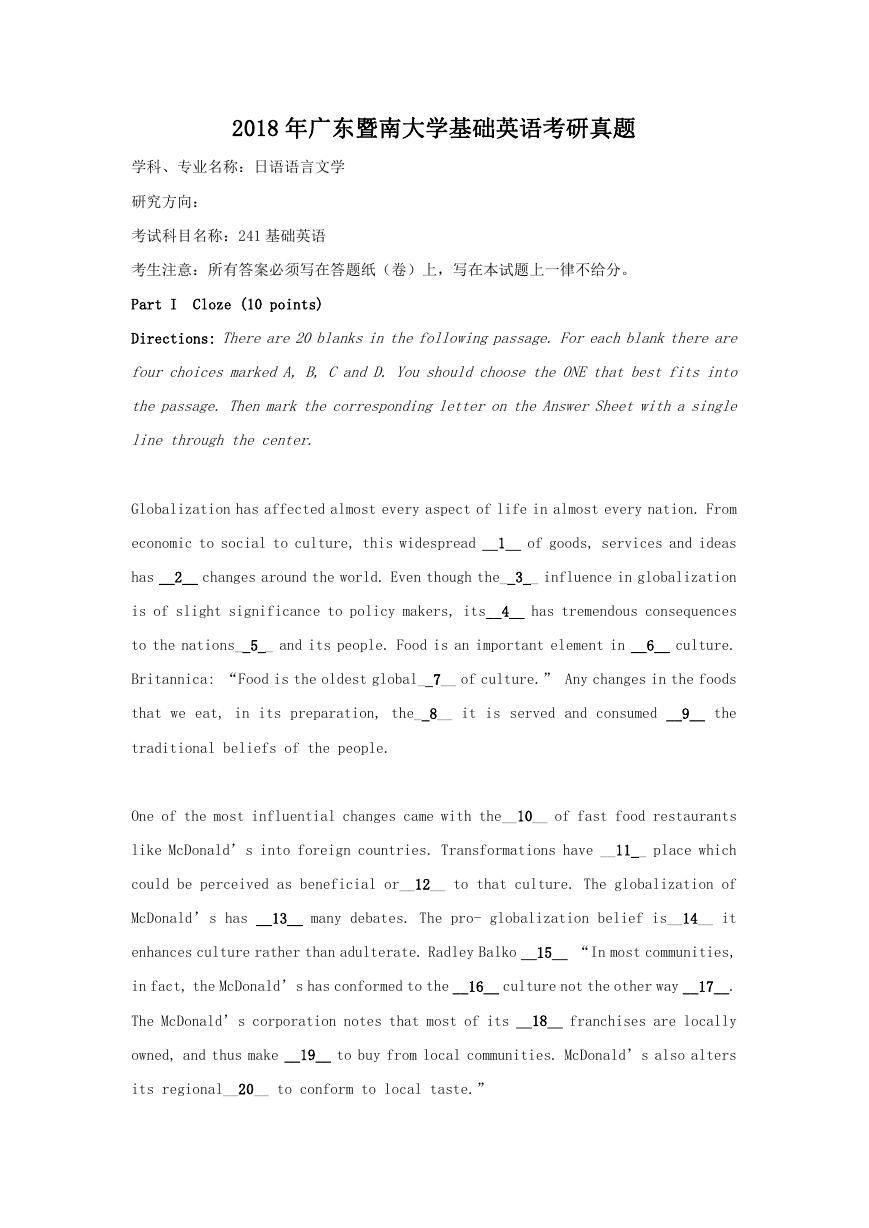
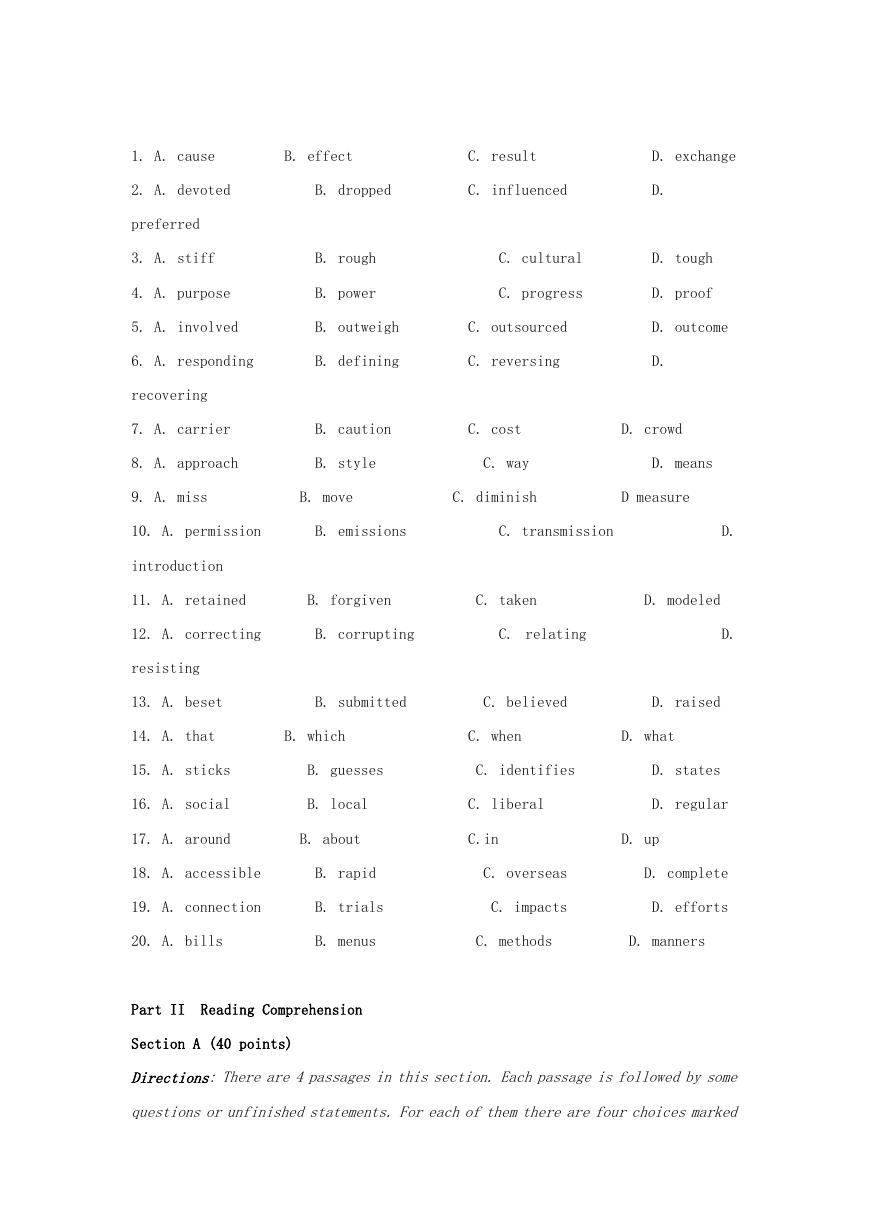
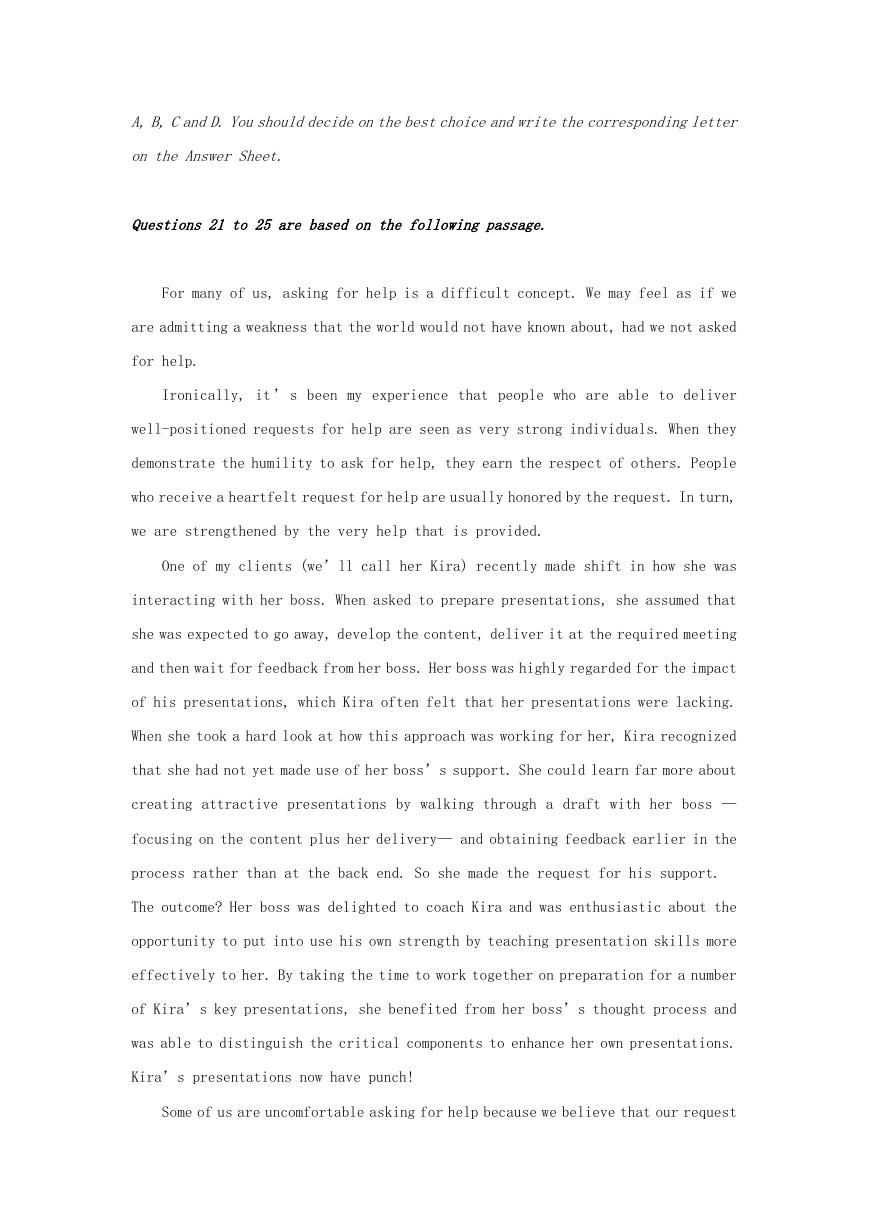
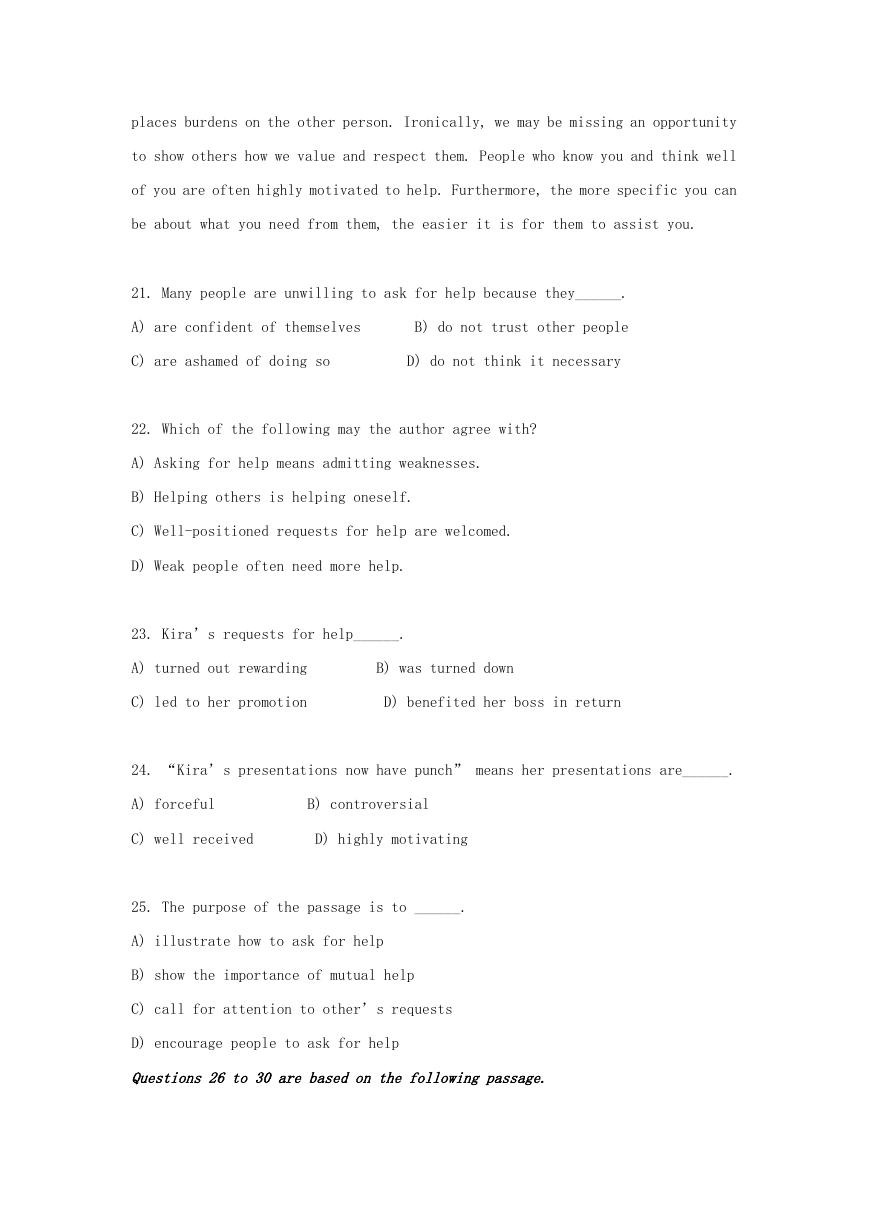
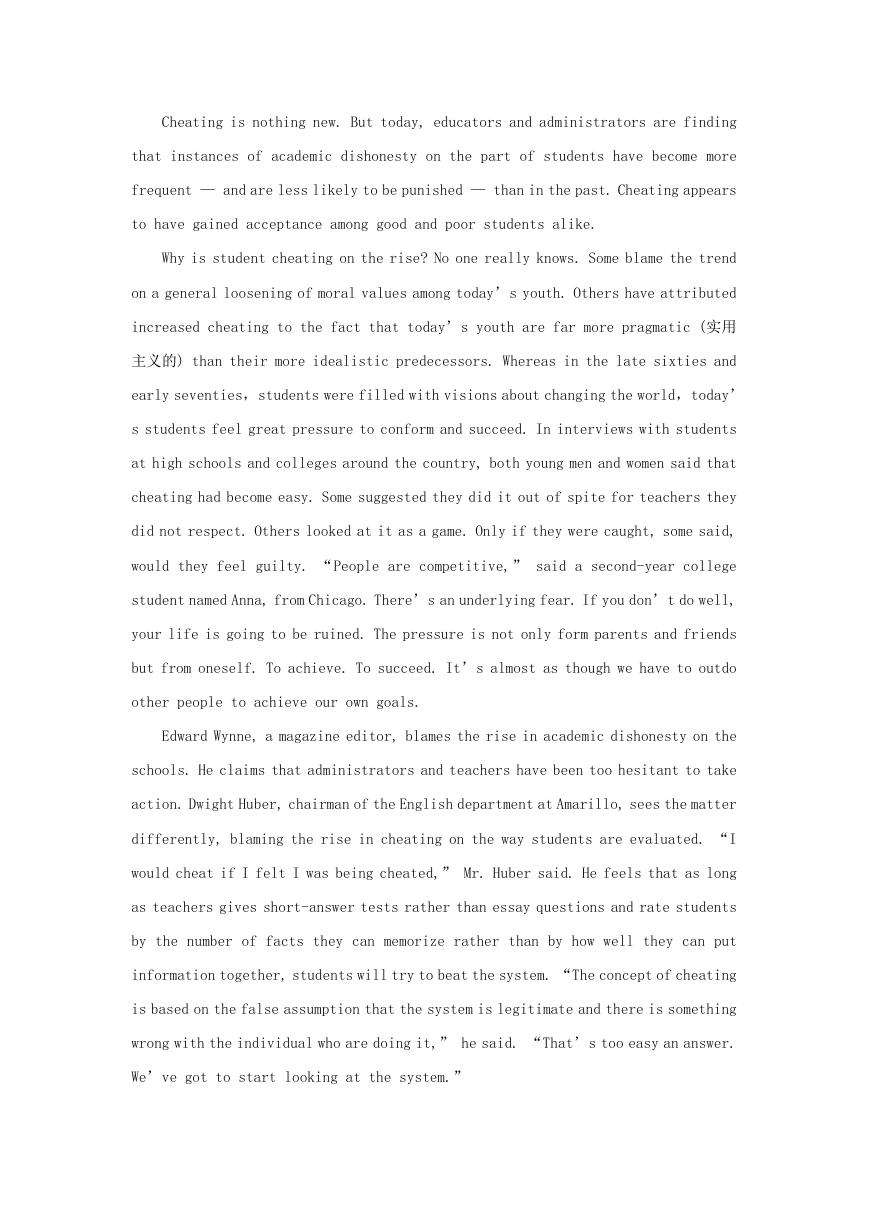

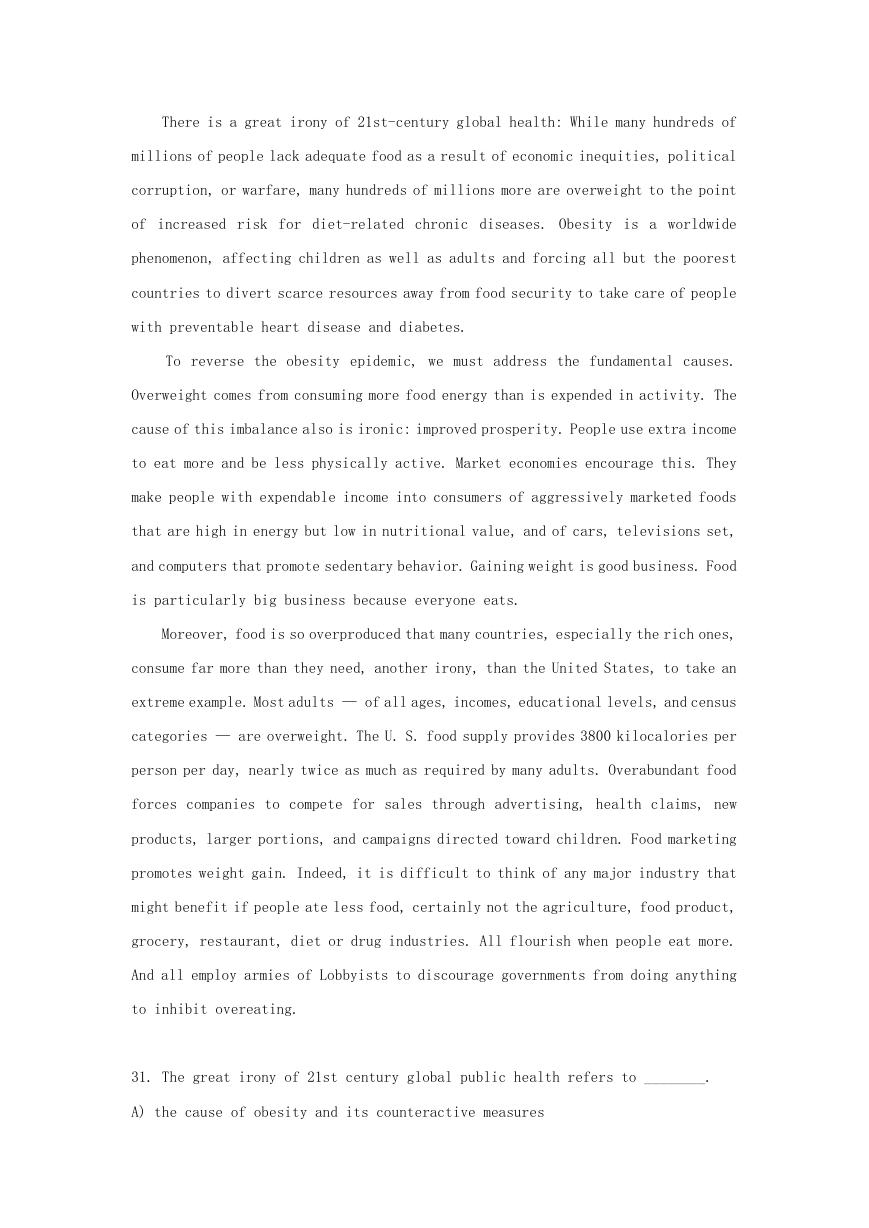









 2023年江西萍乡中考道德与法治真题及答案.doc
2023年江西萍乡中考道德与法治真题及答案.doc 2012年重庆南川中考生物真题及答案.doc
2012年重庆南川中考生物真题及答案.doc 2013年江西师范大学地理学综合及文艺理论基础考研真题.doc
2013年江西师范大学地理学综合及文艺理论基础考研真题.doc 2020年四川甘孜小升初语文真题及答案I卷.doc
2020年四川甘孜小升初语文真题及答案I卷.doc 2020年注册岩土工程师专业基础考试真题及答案.doc
2020年注册岩土工程师专业基础考试真题及答案.doc 2023-2024学年福建省厦门市九年级上学期数学月考试题及答案.doc
2023-2024学年福建省厦门市九年级上学期数学月考试题及答案.doc 2021-2022学年辽宁省沈阳市大东区九年级上学期语文期末试题及答案.doc
2021-2022学年辽宁省沈阳市大东区九年级上学期语文期末试题及答案.doc 2022-2023学年北京东城区初三第一学期物理期末试卷及答案.doc
2022-2023学年北京东城区初三第一学期物理期末试卷及答案.doc 2018上半年江西教师资格初中地理学科知识与教学能力真题及答案.doc
2018上半年江西教师资格初中地理学科知识与教学能力真题及答案.doc 2012年河北国家公务员申论考试真题及答案-省级.doc
2012年河北国家公务员申论考试真题及答案-省级.doc 2020-2021学年江苏省扬州市江都区邵樊片九年级上学期数学第一次质量检测试题及答案.doc
2020-2021学年江苏省扬州市江都区邵樊片九年级上学期数学第一次质量检测试题及答案.doc 2022下半年黑龙江教师资格证中学综合素质真题及答案.doc
2022下半年黑龙江教师资格证中学综合素质真题及答案.doc